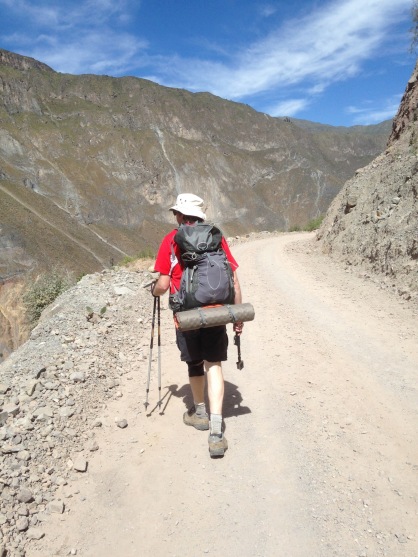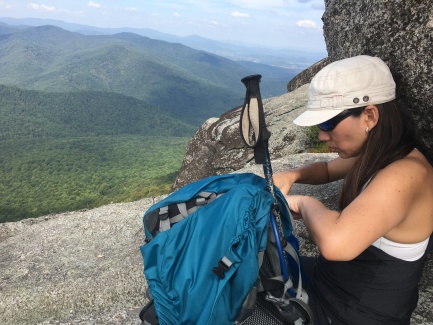The Weight…lightweight, ultra-lightweight and too much weight

Hiking is an evolutionary process. Hikers traditionally start their carers as heavyweight hikers, move towards and through the medium weight hiker-class, eventually end up as contenders for the lightweight hiker belt and might, if they continue to hone their game, end up barely registering on the featherweight scales of the ultra-light class.
The progression of the typical hiker through the weight classes often goes something like this…
Ultra-Heavyweight Champion of the World Hiker. Average pack weight: 50-plus pounds. Hiker is prepared for ANYTHING up to and including blizzard, tsunami, plagues of locusts and attack by fixed wing aircraft. Average number of herniated disks: 2-3. Length of time at this stage: usually one weekend does the trick. (Note this class of hiker may be going extinct; see below.)
Medium-heavyweight hiker. Average pack weight 35-50 pounds. Hiker is prepared for most conditions likely to be encountered, but with low-end, brick and mortar camping gear. Average number of curses and pain pills per mile…several to several hundred. Average length of time at this stage: Six months to 2-3 years depending on the stubbornness of hiker and budget limitations.
The lightweight hiker: Average pack weight 20-35 pounds. Hiker is prepared for most conditions likely to be encountered, but has also invested time, effort and money in minimizing pack weight. The lightweight hiker is most often BETTER prepared than the medium-heavyweight class because they have put more thought into their kit. Average length of time at this stage: Sometimes years, sometimes a lifetime.
Ultra-lightweight hiker: Average pack weight: less than 20 pounds. In ideal cases, lighter than air. Hiker is prepared for some stuff, but that shouldn’t get in the way of the HIKING, damnit! Average length of time until full radicalization: varies; some flirt with this and others plunge in headlong. Typical battle cry: “Clear the trail, you overburdened donkey, I’m an ultra-light hiker!!!”
As you might infer, Brian progressed through stages 1-3 very quickly, then bobbed about a bit flirting with the ultra-lightweight state before bouncing back to lightweight.
Some words about the final (and lightest) stage of the hiking evolutionary tree…
Most do not go very far along the ultra-lightweight branch for the simple reason that below a certain point, weight reduction encounters the law of diminishing returns, rendering the utility gained by further reduction negligible. Or, to put it differently, you can only make a useful pack so light. This generally begins to happen somewhere between 20-25 pounds for a fully loaded backpack; past this point, further weight reductions require:
- Spending a lot of money
- Significant improvisations/modifications to gear
- Materials and methods that are increasingly fragile and prone to failure
- Leaving out important stuff
My intent is not to criticize ultra-light hikers, or to belittle the substantial contributions they have made to the walking universe. For a some VERY different opinions on the subject see the blogs of Ray Jardine, Cam Honan and Andrew Skurka. Cam is especially notable…he hiked over 100 miles across the Cordillera Real of Bolivia (a hike he considers a ‘toughie’) with a pack that he reported to have a base weight (without water and food) of 13 pounds. Obviously, nobody can tell this guy a thing about pack weight.
However, the experts didn’t arrive at their chosen weight class overnight. Some worked at it for years, made investments in lightweight gear, tossed things out you and I might consider essentials. It’s also very likely such a person has a high tolerance for things that would make the average human squeal like a pig. Ulta-lightweight is where, after careful consideration and testing, many of them arrived. Don’t arrive there before you know what it’s all about.
Ultra-light hiking can sometimes be described as an enthusiasm, bordering on obsession. Be aware of several things before you go this route:
- Most ultra-light hikers took a LONG time to get where they got
- Most have spent a lot of time and effort carefully thinking through each of their decisions
- Many are older and have knee and back problems; this may be the only way they can continue their hiking careers
- Most are willing to forgo certain things to achieve the weight reduction
- One of the things they often forgo is a lot of money
We would NOT encourage a novice hiker to the doorstep of ultra-light until they have arrived at this threshold themselves and decide, after careful consideration, to enter. Brian’s own personal belief is ultra-light is not for most people, and that ultra-weight hikers are too often obsessed with reducing each gram of weight to the point where they miss other important considerations.
Perhaps the greatest and most prepared outdoor athlete in the world today is Andrew Skurka. Read his view on it when you get a chance. I won’t attempt to repackage his words, but, in a nutshell, lighter does NOT always mean better. A naked man, for example, travels very light. This man might also end up being very dead.

Note that in today’s market, most hikers will no longer start off in the Ultra-heavyweight class. Up to the early 1980’s, almost all hiking gear was based on equipment designed for car campers, hunters, or for the military, and intended to last forever and be cost effective. It was typically made of wood, stainless steel, canvas or vulcanized rubber, and was quite heavy. To hike the AT in those bygone days, a hiker had to endure the weight of a 50 to 70 pound pack; this is no joke, there was no other way. Long distance hiking was an avocation mostly limited to young, fit, strong men.
All this has changed. Nobody needs carry a 50-pound pack these days unless they want to. Outdoor realtors are in every mall now, as well as online, selling high quality lightweight gear to an avid population of outdoor enthusiasts at reasonable prices. There exists no reason today to go forth into the wild with an apartment building on your back.
Brian’s general advice about weight:
- Build the empire slowly. Do not feel the need to replace every piece of gear in your kit with lightweight alternatives in the course of six weeks.
- Resist the temptation to be ‘prepared for anything!’
- Attack the big-ticket items first: tent, sleeping bag, the pack itself.
- Instead of asking what you need, ask yourself what you DON’T need.
- Eliminate redundancy. Invest in one reliable system rather than an unreliable one and a backup.
- If you pay more money for something AND it is heavier, ask yourself what it gives you that justifies the weight.
- One single piece of somewhat heavy gear that takes the place of several lighter pieces of gear may be worth its weight.
- Do you have a bunch of little things that don’t weigh much by themselves but together weigh a lot? That is sneaky weight. Sneak it out.
- Gear that is damp and dirty will weigh more than dry gear (and compress more poorly.)
- Once you have eliminated the bulk of the weight, and you start doing things like cutting pack straps down to shorten them, ripping off logos, drilling holes in your toothbrush, etc, you are beyond the mountains of the Ultra-Light.
- Eventually you will begin to encounter the law of diminishing weight returns. Instead of stripping away pounds, you will be saving ounces, and then grams.
- There is no great benefit to making your pack just a few ounces lighter. A pack that weighs 19 pounds 7 ounces feels pretty much the same as a pack that weighs 20 pounds, 6 ounces. But the gear you removed or replaced might have caused your kit to lose some utility for little gain.
- When your pack is heavy, question everything. Once your pack begins to get into the lightweight stage (30 pounds or less fully loaded) start questioning what you lose by making it marginally lighter.
- Sadly, there is no such thing as lightweight water.

Here’s a list of things that you should look at to reduce weight. Question the following:
- Any sort of ‘backup’ systems
- Technology, and the batteries it rode in on
- Solar powered (or any) USB chargers
- Cords and plugs
- Any light source that sits on a flat surface or hangs by a hook
- Any mess gear above a pot and spork
- Heavy-assed cameras and camera gear
- Binoculars, monoculars, telescopes and other far-lookies
- Shiny medical instruments
- Snake-bite antivenom kits
- Anything whose purpose is ‘self-defense.’
- Alleged survival gear that stays perpetually submerged at the bottom of your pack
- Anything you have brought for six straight trips and did not once use
- Multi-tools (I carry one, but only after careful consideration)
- Hatchets, saws, machetes and other macho cutlery
- Anything with the logo “Coleman” (hey, it’s legend. So is Stonehenge.)
- Anything purchased in a big chain retailer
- Lumberjack clothes made of wool, fur, flannel, etc
- Extra set of layer zero clothes
- Extra ‘clean’ anything
- ‘toiletries’
- ‘camp shoes’
- Swimsuit (remember you were born in one)
- Food items that you do not absolutely intend to eat
- Food items that are fully hydrated, have wasted weight (skins, cores, crusts, seeds) and don’t compress well (example…an apple vs. dehydrated apple sauce.)
- Any gear that precisely measures how shitty things are (thermometers etc)
- Anything that comes in a bottle or can
- Anything where you say, “Just in case.”
- Camp ‘furniture’
- Sewing kit (see the Universal Repair Component, IE duct tape)
- Bear, wine, spirits (more than once, pal… more than once.)
- Any piece of equipment you do not know how to use
- Anything whose primary use is a pillow
- Packaged hand and foot warmers
- Guidebook (just photocopy the pages you need)
- Collapsible (fill in the blank)
- Inflatable (fill in the blank)
- Depleted uranium, pet rock, life sized replica of Big Ben, barbell set, etc.
One last note about weight. Once you start reaching the law of diminishing weight returns, time and effort might better be spent in improving your conditioning rather than saving another 0.33 ounces. You might also try your hand at acquiring the self-sufficiency skills needed for extended trips to the wild, which can lessen dependency on technology and gear.
Did you know? The full combat load of a World War II US Infantryman has been estimated at 82 pounds including rifle, ammo, kit, clothing and helmet.